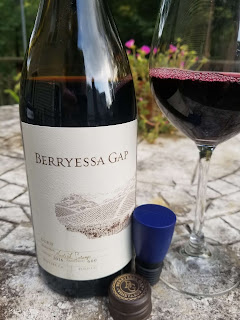"During his studies in the 1860s, Pasteur identified that what he referred to as Mycoderma vini - known as the fleur ("flower") by the vignerons, now known as the microorganisms that create the voile or layer of yeast that settles on the surface of wine in barrels - was different from what was known as Mycoderma aceti or acetic (vinegar) bacteria. He even showed that you could seed the surface of the wine with Mycoderma vini to create the right bouquet - anticipating the use of the ensemencement process by almost a century. " -- Wink Lorch: Jura Wine: With Local Food and Travel Tips
Thus Louis Pasteur, the father of microbiology and pasteurization process should also be known as the father of Vin Jaune - the intentionally oxidized wine produced in his native Jura, France. Lorch continues quoting Jacques Levaux, the retired director of the Jura wine laboratory, "... apart from the rigorous analytical testing, little had changed either in the making or the understanding of Vin Jaune since the time of Pasteur in the mid-19th century".
To paraphrase Lorch, the production of Vin Jaune follows the practice of Spanish sherry where wine (from 100% Savagnin grapes - picked late in the season) are placed in a barrel and not moved or topped for up to six years. Naturally or inoculated, a layer of yeast called voile ("veil") - and similar to Sherry's flor - forms and protects the wine from extreme oxidation and provides a nutty and rich profile. Since the wine in the barrel is never topped and some is lost to evaporation, it is compulsory to use a 62cl clavelin bottle.
Savagnin Blanc is especially suited to its indigenous home in the sub-alpine regions of eastern France. And more specifically, this ancient white wine grape is planted abundantly in eastern Jura, a wine region "sandwiched between Burgundy in the west and Switzerland in the east". DNA reveals that Savagnin is the same as Traminer and associated with the Germanic family of Traminer like Gewurztraminer. But the DNA evidence also revealed that this ancient grape originated in Jura.
Jura's is a cool climate with warm, relatively dry summers and cold winters, and the majority of Jura's vines are planted on south-facing slopes -- to absorb as much of the sun's rays. A minority of vineyards are located in the more mountainous areas of eastern Jura, where heights can reach p to 4,500ft (1370m). However, the majority of vines are planted in the slightly lower-lying land in the west which average 1,000ft (305m).
 |
| Marine fossils |
"It should come as no surprise that the key soil types here are Jurassic limestone and marlstone. The Jurassic period was named after Jura because the region's limestone mountains are representative of the geological developments which occurred between 145 million and 200 million years ago. The name of L'Etoile, the village which is home to one of Jura's most distinctive appellations, is said to be derived from the star-shaped marine fossils which characterize its limestone-rich soils (etoile is French for 'star'). Chablis and the upper Loire Valley are built on a similar geological structure". --
wine-searcher
Jura was once one of France's most prolific wine regions and dominated by red grape varieties. However, according to Lorch, "during the phylloxera crisis, from the peak of plantations in 1873 to 1900, the vineyard area reduced in the Jura by 62% - compared to 27% on average for France as a whole". These vines had also been declining due to powdery mildew and then add in two World Wars -- and Jura wine production was basically broke at the beginning of the 1960s.
Local, governmental, and individual (think Henri Maire) efforts contributed to the steady rebound in Jura wines that have benefitted local producers such as the
Domaine de Sainte Marie. This winery has a 14 hectare (35 acres) estate which is planted with 85% Savagnin. These grapes are used to make Vin Jaune but are also blended with others to produce AOC Cotes du Jura & L'Etoile wines as well as the Vin de Paille dessert wine. Like Savagnin, the family de Sainte Marie is an ancient one tracing their Norman ancestors to the 12 century and having resided in Jura for over 200 years. Today "..the growing estate is built around Bertrand de Sainte Marie, his son Gaëtan, and oenologist Nicolas Cottier to create top-of-the-range wines, worthy of their appellations, made from traditional Jura grape varieties such as Savagnin, Chardonnay, Poulsard and Trousseau".

Domaine de Sainte Marie participated in the
Hopwine program and from the kit I received, it appears that the estate is well on their way to not only meet but exceed that goal. The
2017 L'Etoile Ensemblage is a textured and acidic blend of Savagnin, Chardonnay, and Poulsard -- the later a red wine grown as a white wine. The
2012 Cotes du Jura Vin de Paille is made from Savagnin, Chardonnay, Poulsard, or Trousseau grapes that have been placed on loosely woven mats made of straw (paille) and dried out for several weeks (or even months). This process concentrates the sugars and flavors providing an auburn colored wine with intense sweet flavors and funk but lifted with refreshing acidity. And finally, there's the
2010 Cotes du Jura Vin Jaune that is one of the highlights of the entire Hopwine shipment of 30 individual winery kits. It is aromatic, with a clean profile of nuts and honey with rising acids. And excellent.
Domaine de Sainte Marie is looking for a U.S. importer and distributor so hopefully, their wines will be available in the near future.




















































